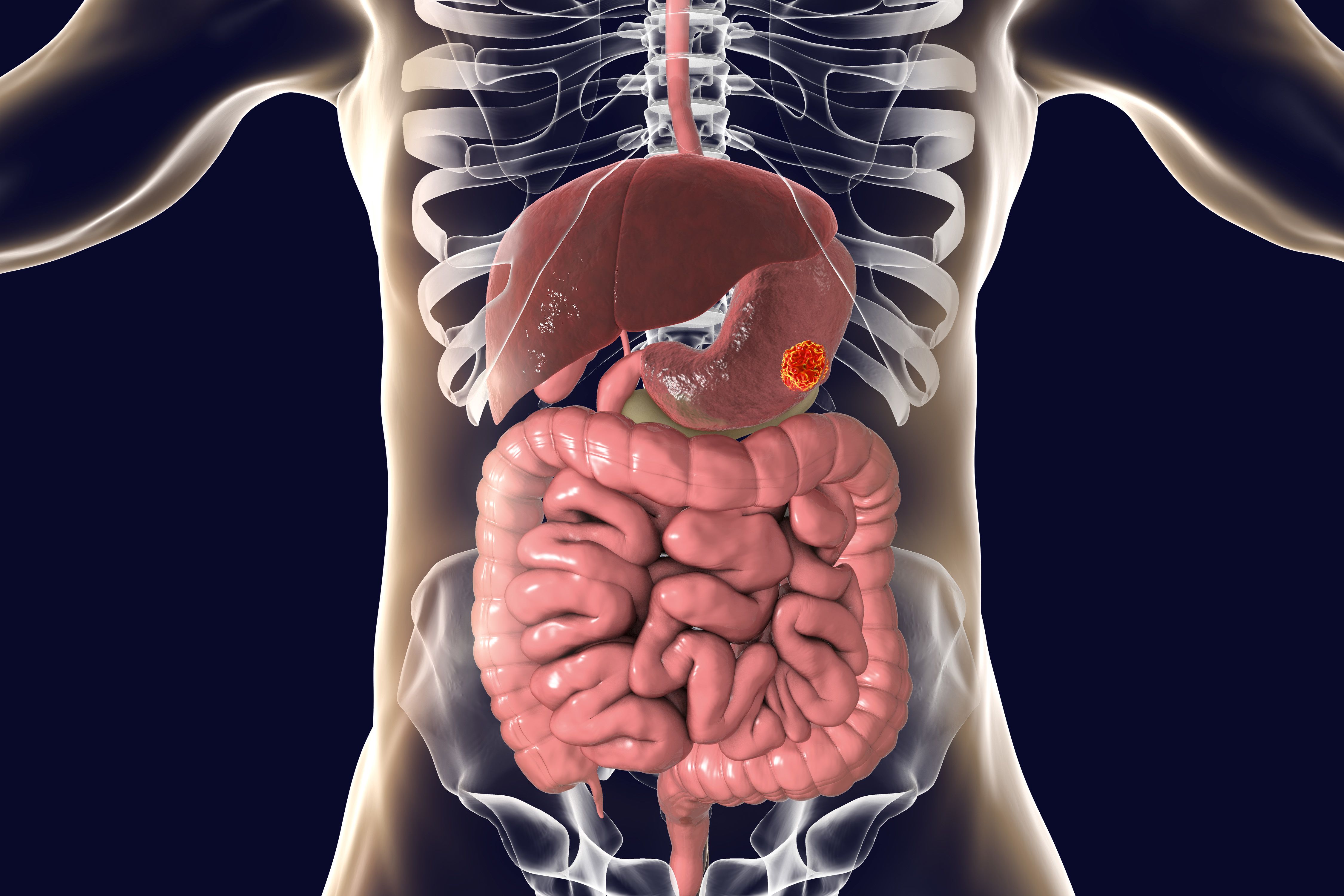Cadonilimab Plus Chemo Provides Survival Benefit in Gastric/GEJ Cancer
Patients with gastric/GEJ adenocarcinoma treated with cadonilimab plus oxaliplatin and capecitabine obtained a survival benefit regardless of PD-L1 expression.
Cadonilimab Plus Chemo Provides Survival Benefit in Gastric/GEJ Cancer

Patients with advanced gastric or gastroesophageal junction (GEJ) adenocarcinoma treated with the first-in-class humanized bispecific antibody cadonilimab (AK104) plus oxaliplatin and capecitabine (Xelox) derived a survival advantage regardless of PD-L1 expression, according to data presented during the 2024 AACR Annual Meeting.1
“Cadonilimab is the first PD-1/CTLA-4 bispecific antibody to demonstrate statistically significant and clinically meaningful overall survival [OS] and progression-free survival [PFS] benefits in combination with chemotherapy vs chemotherapy alone in previously untreated patients with advanced gastric/GEJ adenocarcinoma,” Jiafu Ji, MD, PhD, DrPH, of Peking University Hospital in Beijing, China, said in a presentation of the data.
Data from the phase 3 COMPASSION-15/AK104-302 trial (NCT05008783) revealed that patients included in the intention-to-treat (ITT) population who were treated in the combination therapy arm (n = 305) achieved a median OS of 15.0 months (95% CI, 12.3-19.3) compared with 10.8 months (95% CI, 9.8-12.0) for those in the placebo arm (n = 305; HR, 0.6; 95% CI, 0.5-0.78; P < .001); 18-month OS rates were 45.8% vs 25.5%, respectively. In the PD-L1 combined positive score (CPS) of 5 or greater group, patients who were treated with the combination (n = 116) experienced a median OS that was not reached (95% CI, 11.4-not estimable) vs a 10.6 months OS (95% CI, 8.8-12.8) for those treated with placebo (n = 140; HR, 0.58; 95% CI, 0.39-0.80; P < .001); the 18-month OS rates were 51.2% vs 23.5%, respectively.
Further, patients with a PD-L1 CPS of less than 5 in the cadonilimab plus oxaliplatin and capecitabine arm (n = 157) achieved a median OS of 14.8 months (95% CI, 11.8-18.8) compared with 11.1 months (95% CI, 10.1-13.0) in the placebo plus oxaliplatin and capecitabine arm (n = 147; HR, 0.70; 95% CI, 0.51-0.95; P = .011). The 18-month OS rates were 44.1% compared with 27.5%, respectively.
“Cadonilimab plus chemotherapy represents a new potential standard [first] line treatment for patients with advanced gastric/GEJ adenocarcinoma, especially in patients with low PD-L1 expression,” Ji said. “Cadonilimab showed a survival advantage in [patients with] gastric cancer with low PD-L1 expression, which was not shown in other phase 3 trials with PD-1 antibodies.”
In June 2022, cadonilimab was approved in China for the treatment of patients with recurrent and metastatic cervical cancer who progressed on or following platinum-based chemotherapy.2 Further, as the COMPASSION-15 trial met its primary end point showing an OS benefit, the China National Medical Products Administration accepted the supplemental new drug application for cadonilimab plus oxaliplatin and capecitabine for the first-line treatment of unresectable locally advanced, recurrent/metastatic gastric or GEJ adenocarcinoma.3
Looking to Enrollment Criteria in COMPASSION-15/AK104-302
COMPASSION-15 was a double-blind trial that randomly assigned patients to receive 10 mg/kg of cadonilimab plus oxaliplatin and capecitabine or placebo plus oxaliplatin and capecitabine every 3 weeks for up to 6 cycles. Capecitabine was administered at 1000 mg/m2 orally twice daily on days 1 through 14 every 3 weeks and oxaliplatin intravenously at 130 mg/m2 every 3 weeks. Following the 6 cycles, patients then received 10 mg/kg cadonilimab monotherapy or placebo every 3 weeks.1
Patients enrolled were 18 to 75 years of age with a life expectancy of at least 3 months. Patients were not eligible for enrollment if they received prior systemic therapy and must have had locally advanced unresectable or metastatic gastric or GEJ adenocarcinoma with measurable tumor lesions by RECIST 1.1 criteria. Additionally, patients were stratified based on ECOG performance status (0 vs 1), PD-L1 expression (CPS of 5% or greater vs less than 5%-not evaluable), and liver metastases (yes vs no).
The primary end point of the trial was OS in the ITT population and secondary end points included OS in the CPS of 5 or greater population, safety pharmacokinetics, health-related quality of life, and antibody-drug antibodies. Investigator-assessed PFS, overall response rate, disease control rate, and duration of response were also secondary end points in the ITT and CPS of 5 or greater populations.
No New Safety Signals Observed
In COMPASSION-15, grade 3 or higher treatment-related adverse effects (TRAEs) occurred in 65.9% of patients receiving the combination (n = 305) vs 53.6% of patients receiving placebo (n = 304). TRAEs led to discontinuation in 23.9% vs 6.6% of patients, respectively. Ji highlighted that no new safety signals were observed, and these rates with the combination were comparable to those seen in the phase 3 CheckMate 649 (NCT02872116) and KEYNOTE-859 (NCT03675737) trials.
Additional Data and Future Directions With Cadonilimab
PFS benefits were also seen with the cadonilimab/chemotherapy combination vs placebo and chemotherapy regardless of PD-L1 expression. In the ITT population, patients experienced a median PFS of 7.0 months (95% CI, 6.4-8.4) vs 5.3 months (95% CI, 4.5-5.6), respectively (HR, 0.53; 95% CI, 0.44-0.65; P < .001); the 9-month PFS rates were 42.2% vs 16.9%, respectively.
In the PD-L1 CPS of 5 or greater group, the median PFS was 6.9 months (95% CI, 5.6-9.9) in the combination arm vs 5.5 months (95% CI, 4.5-5.8) in the placebo arm (HR, 0.51; 95% CI, 0.37-0.70; P < .001); 9-month rates were 40.9% vs 15.1%, respectively. Further, in the PD-L1 CPS of less than 5 group, the median PFS was 6.9 months (95% CI, 5.7-9.0) compared with 4.6 months (95% CI, 4.3-5.6), respectively (HR, 0.60; 95% CI, 0.45-0.79; P < .001); the 9-month PFS rates were 41.7% vs 17.7%, respectively.
Several phase 3 trials are currently ongoing evaluating cadonilimab in various tumor types, including the COMPASSION-16 trial in cervical cancer.
References
- Ji J, Shen L, Li Z, et al. Cadonilimab plus chemotherapy versus chemotherapy as first-line treatment for unresectable locally advanced or metastatic gastric or gastroesophageal junction (G/GEJ) adenocarcinoma (COMPASSION-15): A randomized, double-blind, phase 3 trial. Presented at: 2024 AACR Annual Meeting; April 5-10, 2024; San Diego, CA.
- Akeso’s cadonilimab (PD-1/CTLA-4), the first dual immune checkpoint inhibitor to treat cancer, approved for marketing in China. Akeso. News release. June 29, 2022. Accessed April 7, 2024. https://www.akesobio.com/en/media/akeso-news/20220629/
- Supplemental new drug application for Akeso’s cadonilimab (PD-1/CTLA-4) accepted by NMPA for first-line treatment of gastric cancer. News release. Akeso, Inc. January 5, 2024. Accessed April 7, 2024. https://www.prnewswire.com/news-releases/supplemental-new-drug-application-for-akesos-cadonilimab-pd-1ctla-4-accepted-by-nmpa-for-first-line-treatment-of-gastric-cancer-302027004.html
Survival Benefit, Durable Responses Continue at 3 Years With Liso-cel in Second-line LBCL
July 15th 2024Three-year findings from the TRANSFORM trial provide further evidence that liso-cel should be considered as the new standard of care along with other CAR T-cell therapies for patients with primary refractory or relapsed LBCL, an expert said.



